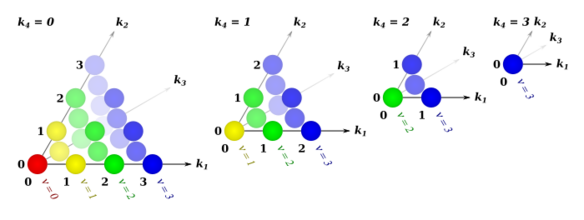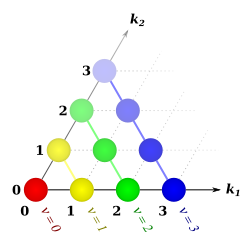Pascal's simplex
In mathematics, Pascal's simplex is a generalisation of Pascal's triangle into arbitrary number of dimensions, based on the multinomial theorem.
Generic Pascal's m-simplex
Let m (m > 0) be a number of terms of a polynomial and n (n ≥ 0) be a power the polynomial is raised to.
Let [math]\displaystyle{ \wedge^m }[/math] denote a Pascal's m-simplex. Each Pascal's m-simplex is a semi-infinite object, which consists of an infinite series of its components.
Let [math]\displaystyle{ \wedge^m_n }[/math] denote its nth component, itself a finite (m − 1)-simplex with the edge length n, with a notational equivalent [math]\displaystyle{ \vartriangle^{m-1}_n }[/math].
nth component
[math]\displaystyle{ \wedge^m_n = \vartriangle^{m-1}_n }[/math] consists of the coefficients of multinomial expansion of a polynomial with m terms raised to the power of n:
- [math]\displaystyle{ |x|^n=\sum_{|k|=n}{\binom{n}{k}x^k};\ \ x\in\mathbb{R}^m,\ k\in\mathbb{N}^m_0,\ n\in\mathbb{N}_0,\ m\in\mathbb{N} }[/math]
where [math]\displaystyle{ \textstyle|x|=\sum_{i=1}^m{x_i},\ |k|=\sum_{i=1}^m{k_i},\ x^k=\prod_{i=1}^m{x_i^{k_i}} }[/math].
Example for [math]\displaystyle{ \wedge^4 }[/math]
Pascal's 4-simplex (sequence A189225 in the OEIS), sliced along the k4. All points of the same color belong to the same n-th component, from red (for n = 0) to blue (for n = 3).
Specific Pascal's simplices
Pascal's 1-simplex
[math]\displaystyle{ \wedge^1 }[/math] is not known by any special name.
nth component
[math]\displaystyle{ \wedge^1_n = \vartriangle^0_n }[/math] (a point) is the coefficient of multinomial expansion of a polynomial with 1 term raised to the power of n:
- [math]\displaystyle{ (x_1)^n = \sum_{k_1=n} {n \choose k_1} x_1^{k_1};\ \ k_1, n \in \mathbb{N}_0 }[/math]
Arrangement of [math]\displaystyle{ \vartriangle^0_n }[/math]
- [math]\displaystyle{ \textstyle {n \choose n} }[/math]
which equals 1 for all n.
Pascal's 2-simplex
[math]\displaystyle{ \wedge^2 }[/math] is known as Pascal's triangle (sequence A007318 in the OEIS).
nth component
[math]\displaystyle{ \wedge^2_n = \vartriangle^1_n }[/math] (a line) consists of the coefficients of binomial expansion of a polynomial with 2 terms raised to the power of n:
- [math]\displaystyle{ (x_1 + x_2)^n = \sum_{k_1+k_2=n} {n \choose k_1, k_2} x_1^{k_1} x_2^{k_2};\ \ k_1, k_2, n \in \mathbb{N}_0 }[/math]
Arrangement of [math]\displaystyle{ \vartriangle^1_n }[/math]
- [math]\displaystyle{ \textstyle {n \choose n, 0}, {n \choose n - 1, 1}, \cdots, {n \choose 1, n - 1}, {n \choose 0, n} }[/math]
Pascal's 3-simplex
[math]\displaystyle{ \wedge^3 }[/math] is known as Pascal's tetrahedron (sequence A046816 in the OEIS).
nth component
[math]\displaystyle{ \wedge^3_n = \vartriangle^2_n }[/math] (a triangle) consists of the coefficients of trinomial expansion of a polynomial with 3 terms raised to the power of n:
- [math]\displaystyle{ (x_1 + x_2 + x_3)^n = \sum_{k_1+k_2+k_3=n} {n \choose k_1, k_2, k_3} x_1^{k_1} x_2^{k_2} x_3^{k_3};\ \ k_1, k_2, k_3, n \in \mathbb{N}_0 }[/math]
Arrangement of [math]\displaystyle{ \vartriangle^2_n }[/math]
- [math]\displaystyle{ \begin{align} \textstyle {n \choose n, 0, 0} &, \textstyle {n \choose n - 1, 1, 0}, \cdots\cdots, {n \choose 1, n - 1, 0}, {n \choose 0, n, 0}\\ \textstyle {n \choose n - 1, 0, 1} &, \textstyle {n \choose n - 2, 1, 1}, \cdots\cdots, {n \choose 0, n - 1, 1}\\ &\vdots\\ \textstyle {n \choose 1, 0, n - 1} &, \textstyle {n \choose 0, 1, n - 1}\\ \textstyle {n \choose 0, 0, n} \end{align} }[/math]
Properties
Inheritance of components
[math]\displaystyle{ \wedge^m_n = \vartriangle^{m-1}_n }[/math] is numerically equal to each (m − 1)-face (there is m + 1 of them) of [math]\displaystyle{ \vartriangle^m_n = \wedge^{m+1}_n }[/math], or:
- [math]\displaystyle{ \wedge^m_n = \vartriangle^{m-1}_n \subset\ \vartriangle^m_n = \wedge^{m+1}_n }[/math]
From this follows, that the whole [math]\displaystyle{ \wedge^m }[/math] is (m + 1)-times included in [math]\displaystyle{ \wedge^{m+1} }[/math], or:
- [math]\displaystyle{ \wedge^m \subset \wedge^{m+1} }[/math]
Example
[math]\displaystyle{ \wedge^1 }[/math] [math]\displaystyle{ \wedge^2 }[/math] [math]\displaystyle{ \wedge^3 }[/math] [math]\displaystyle{ \wedge^4 }[/math] [math]\displaystyle{ \wedge^m_0 }[/math] 1 1 1 1 [math]\displaystyle{ \wedge^m_1 }[/math] 1 1 1 1 1 1 1 1 1 1 [math]\displaystyle{ \wedge^m_2 }[/math] 1 1 2 1 1 2 1 1 2 1 2 2 1 2 2 2 2 2 1 1 [math]\displaystyle{ \wedge^m_3 }[/math] 1 1 3 3 1 1 3 3 1 1 3 3 1 3 6 3 3 3 1 3 6 3 3 6 3 6 6 3 3 3 3 3 3 1 1
For more terms in the above array refer to (sequence A191358 in the OEIS)
Equality of sub-faces
Conversely, [math]\displaystyle{ \wedge^{m+1}_n = \vartriangle^m_n }[/math] is (m + 1)-times bounded by [math]\displaystyle{ \vartriangle^{m-1}_n = \wedge^m_n }[/math], or:
- [math]\displaystyle{ \wedge^{m+1}_n = \vartriangle^m_n \supset \vartriangle^{m-1}_n = \wedge^m_n }[/math]
From this follows, that for given n, all i-faces are numerically equal in nth components of all Pascal's (m > i)-simplices, or:
- [math]\displaystyle{ \wedge^{i+1}_n = \vartriangle^i_n \subset \vartriangle^{m\gt i}_n = \wedge^{m\gt i+1}_n }[/math]
Example
The 3rd component (2-simplex) of Pascal's 3-simplex is bounded by 3 equal 1-faces (lines). Each 1-face (line) is bounded by 2 equal 0-faces (vertices):
2-simplex 1-faces of 2-simplex 0-faces of 1-face
1 3 3 1 1 . . . . . . 1 1 3 3 1 1 . . . . . . 1
3 6 3 3 . . . . 3 . . .
3 3 3 . . 3 . .
1 1 1 .
Also, for all m and all n:
- [math]\displaystyle{ 1 = \wedge^1_n = \vartriangle^0_n \subset \vartriangle^{m-1}_n = \wedge^m_n }[/math]
Number of coefficients
For the nth component ((m − 1)-simplex) of Pascal's m-simplex, the number of the coefficients of multinomial expansion it consists of is given by:
- [math]\displaystyle{ {(n-1) + (m-1) \choose (m-1)} + {n + (m - 2) \choose (m - 2)} = {n + (m - 1) \choose (m - 1)} = \left( \binom{m}{n} \right), }[/math]
(where the latter is the multichoose notation). We can see this either as a sum of the number of coefficients of an (n − 1)th component ((m − 1)-simplex) of Pascal's m-simplex with the number of coefficients of an nth component ((m − 2)-simplex) of Pascal's (m − 1)-simplex, or by a number of all possible partitions of an nth power among m exponents.
Example
| m-simplex | nth component | n = 0 | n = 1 | n = 2 | n = 3 | n = 4 | n = 5 |
|---|---|---|---|---|---|---|---|
| 1-simplex | 0-simplex | 1 | 1 | 1 | 1 | 1 | 1 |
| 2-simplex | 1-simplex | 1 | 2 | 3 | 4 | 5 | 6 |
| 3-simplex | 2-simplex | 1 | 3 | 6 | 10 | 15 | 21 |
| 4-simplex | 3-simplex | 1 | 4 | 10 | 20 | 35 | 56 |
| 5-simplex | 4-simplex | 1 | 5 | 15 | 35 | 70 | 126 |
| 6-simplex | 5-simplex | 1 | 6 | 21 | 56 | 126 | 252 |
The terms of this table comprise a Pascal triangle in the format of a symmetric Pascal matrix.
Symmetry
An nth component ((m − 1)-simplex) of Pascal's m-simplex has the (m!)-fold spatial symmetry.
Geometry
Orthogonal axes [math]\displaystyle{ k_1 ... k_m }[/math] in m-dimensional space, vertices of component at n on each axe, the tip at [0,...,0] for [math]\displaystyle{ n=0 }[/math].
Numeric construction
Wrapped n-th power of a big number gives instantly the n-th component of a Pascal's simplex.
- [math]\displaystyle{ \left|b^{dp}\right|^n=\sum_{|k|=n}{\binom{n}{k}b^{dp\cdot k}};\ \ b,d\in\mathbb{N},\ n\in\mathbb{N}_0,\ k,p\in\mathbb{N}_0^m,\ p:\ p_1=0, p_i=(n+1)^{i-2} }[/math]
where [math]\displaystyle{ \textstyle b^{dp} = (b^{dp_1},\cdots,b^{dp_m})\in\mathbb{N}^m,\ p\cdot k={\sum_{i=1}^m{p_i k_i}}\in\mathbb{N}_0 }[/math].
This article does not cite any external source. HandWiki requires at least one external source. See citing external sources. (2021) (Learn how and when to remove this template message) |
 |





